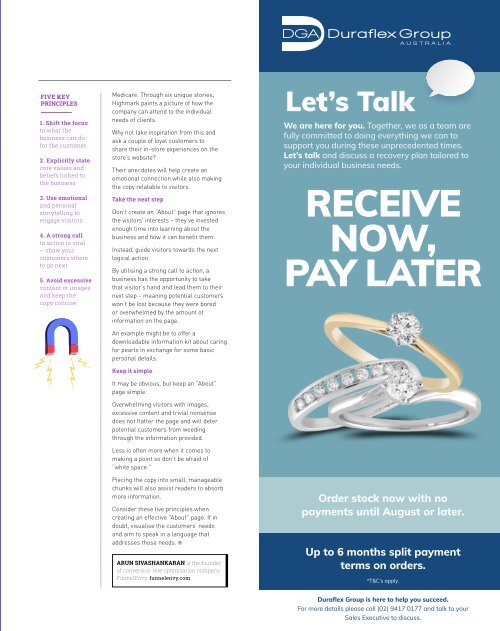Jeweller - May 2020
• Corona catch-up: news and updates on the latest COVID-19 policies, plans and goals • Rocky road: how the coronavirus crisis has shaken the international diamond trade • New perspective: managing your mindset amid uncertain times
• Corona catch-up: news and updates on the latest COVID-19 policies, plans and goals
• Rocky road: how the coronavirus crisis has shaken the international diamond trade
• New perspective: managing your mindset amid uncertain times
You also want an ePaper? Increase the reach of your titles
YUMPU automatically turns print PDFs into web optimized ePapers that Google loves.
FIVE KEY<br />
PRINCIPLES<br />
1. Shift the focus<br />
to what the<br />
business can do<br />
for the customer<br />
2. Explicitly state<br />
core values and<br />
beliefs linked to<br />
the business<br />
3. Use emotional<br />
and personal<br />
storytelling to<br />
engage visitors<br />
4. A strong call<br />
to action is vital<br />
– show your<br />
customers where<br />
to go next<br />
5. Avoid excessive<br />
content or images<br />
and keep the<br />
copy concise<br />
Medicare. Through six unique stories,<br />
Highmark paints a picture of how the<br />
company can attend to the individual<br />
needs of clients.<br />
Why not take inspiration from this and<br />
ask a couple of loyal customers to<br />
share their in-store experiences on the<br />
store’s website?<br />
Their anecdotes will help create an<br />
emotional connection while also making<br />
the copy relatable to visitors.<br />
Take the next step<br />
Don’t create an ”About” page that ignores<br />
the visitors’ interests – they’ve invested<br />
enough time into learning about the<br />
business and how it can benefit them.<br />
Instead, guide visitors towards the next<br />
logical action.<br />
By utilising a strong call to action, a<br />
business has the opportunity to take<br />
that visitor’s hand and lead them to their<br />
next step – meaning potential customers<br />
won’t be lost because they were bored<br />
or overwhelmed by the amount of<br />
information on the page.<br />
An example might be to offer a<br />
downloadable information kit about caring<br />
for pearls in exchange for some basic<br />
personal details.<br />
Keep it simple<br />
It may be obvious, but keep an ”About”<br />
page simple.<br />
Overwhelming visitors with images,<br />
excessive content and trivial nonsense<br />
does not flatter the page and will deter<br />
potential customers from weeding<br />
through the information provided.<br />
Less is often more when it comes to<br />
making a point so don’t be afraid of<br />
“white space.”<br />
Piecing the copy into small, manageable<br />
chunks will also assist readers to absorb<br />
more information.<br />
Consider these five principles when<br />
creating an effective ”About” page. If in<br />
doubt, visualise the customers’ needs<br />
and aim to speak in a language that<br />
addresses those needs.<br />
ARUN SIVASHANKARAN is the founder<br />
of conversion rate optimisation company<br />
FunnelEnvy. funnelenvy.com


















